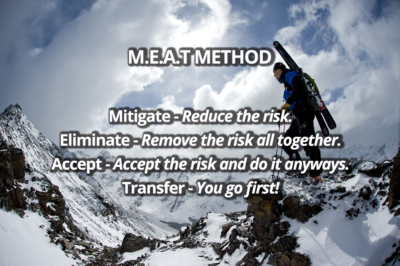Aug 9, 2016
Simplifying The Risk Management Process
For many people, when they hear the term risk management, the words complicated, processes and logistics come to mind. However, risk management is a natural process that we use in business and life. In many cases, we analyze and measure risk on a daily basis in our lives and in our organizations.
What is Risk Management?
Risk management is the identification, prioritization, and assessment of risk. Once you have identified, prioritized, and assessed potential risk, you should attempt to minimize, monitor, and control the probability of the risk happening.
A proper risk management practice is to be proactive rather than reactive. You cannot wait for a problem to arise before taking steps to manage it. You have to start managing risk before it becomes a problem. A good example of being proactive is how jet fighters have parachutes and ejector seats in case of a situation that requires the pilot to exit the plane.
A network is another good example. When IT departments set up networks, they usually set up firewalls and antivirus systems too. This is because they are reducing the probability that a hacker would attempt to break into their systems.
You probably wouldn’t buy a car without airbags. This is because you may have already assessed the risks of having a car. In the world of cars that we live with today, a car without an airbag system is incredibly risky.
One more example before we move on. Assuming that your team is charged with developing a new product for your company and you were asked to collect ideas from everyone within your organization.
There are several risk factors that you must take into account but the main risk in this scenario is selecting the wrong idea.
Therefore, you must assess and evaluate every idea that you receive before you take action on them. Many organizations use some form of risk management tool to process ideas.
Proper risk management will always reduce the likelihood of an event happening and the damage if that event occurred.
The Importance of Risk Management to Organizations
Risk management is important because it helps organizations reduce loss. Loss can be in the form of monetary assets, people, and systems. There are four main purposes of risk management and here they are.
- Reduce risk.
- Identify potential risks.
- Provide a rational basis for making decisions.
- Plan for the future.
Assessing and managing risk are the best defense against future problems in your organization.
By evaluating risk and coming up with strategies to address them, you will increase your chances of success in any project that you undertake. However, you must treat risk management as a continuous and ongoing process for it to be more effective.
“I have learned that nothing is certain except for the need to have strong risk management, a lot of cash, the willingness to invest even when the future is unclear, and great people”.
Jeffrey R. Immelt, Chief Executive Officer of General Electric.
Risk Management Systems or RIMS
A risk management system or risk management information system (RMIS) is a system that enables a company to manage and control the overall cost of risk management. The management of risk data and the information is key to a successful risk management strategy.
Risk management systems are designed to identify risk but they are also able to measure and predict the impact of a given risk. Once you are able to see all the risk factors involved, you can decide to either accept the risk or not. The acceptance or non-acceptance of risk will depend on your risk tolerance level.
If you treat risk management as a continuous process, you will reduce unwanted surprises. A good risk management system will help you further your goals and control cost.
6 Questions That Will Help You With Risk Management
David Hillson, a thought leader in risk management who also goes by “The Risk Doctor”, explains that you can structure the risk management process by asking and answering six simple questions.
- What am I trying to achieve? This involves understanding the scope, context, and the environment that you wish to manage risk. This is the first step in the risk management process.
- What might affect me? Look for things out there that can hurt or help your goals. This is essentially risk identification and knowing the uncertainties that matter, as well as probable future events that may help or hurt you.
- Which are the most important ones? Which of those things that might affect you are the most important. Not everything that you identify will be equally important. This is the step of risk assessment or evaluation or analysis in the risk management process.
- What should we do about it? This is the most important question because you may become the victim of uncertainty and things might happen in your project that you are not expecting.
- Did it work? This is assessing if the strategies that you put in place worked or if you need to modify your approach and try again.
- What changed? Business is always changing and it is important that you can spot the new risks that arise from the last time that you took action.
By building your risk management process around these six questions, risk management will become easier to implement.
Risk Management and The M.E.A.T Method
Chris Davenport, an accomplished big-mountain skier, and mountaineer states that he broke down the risk management process into four steps. He calls these steps, the M.E.A.T method.
You may be thinking steak or some other type of meat but it’s not about that. M.E.A.T means to mitigate, eliminate, accept, and transfer.
You may also use this method to simplify your risk management process.

What’s Your Risk Management Process?
Let us know and let’s find out if we can help with your woes, in the comments below.